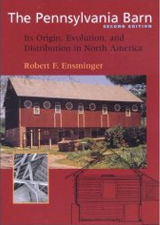Book Review
The Pennsylvania Barn: Its Origin, Evolution and Distribution in North America
By Robert F. Ensminger. Second Edition, Baltimore, MD: Johns Hopkins University Press, 2003; 348 pp., diagrams, photographs, appendices, glossary, bibliography, index; paper $28.00.
 |
Scholars can be an intellectually persistent lot, especially when the subject before them is as visually inviting and iconographic as the Pennsylvania barn. Fortunately for serious material culture practitioners, Robert Ensminger, folklorist, lecturer, and cultural geographer of considerable credentials, has elevated the weekend practices of "barn crawls" and "barnstorming" to a new level of study and appreciation. Reading the second edition of The Pennsylvania Barn is like sitting at the kitchen table with an old friend.
Ensminger's meticulous 1992 study of the Pennsylvania barn has been extensively revisted and reaffirmed. Additional barns have been studied, experts consulted, and classifications refined. As a result, one-third of the original text has been updated. A central conclusion of the first edition continues to hold up, namely that Pennsylvania barns "remain surprisingly constant over considerable distances." True of almost any serious investigation, the book answers several questions while raising others. 1790 tax records, for example, reveal that most structures in Pennsylvania were built of log, and in those counties with the highest percentage of stone buildings, stonemasons tended to be primarily of English and Scots-Irish ancestry rather than German as is widely assumed.
Among the volume's more fundamental conclusions is how cultural assimilation and simple labor-saving techniques in the Pennsylvania hearth, particularly during the late 18th century, influenced subsequent barn structure and form. Such social and material diffusion is evident through the use of lighter English rafter systems, stone closed-forebays, and Anglo-influenced barnyard enclosures. Through diagnostic elements, Ensminger traces barn evolution from the continental stehender Stuhl to the canted-queen-post triangular truss, a simple yet profoundly successful roof frame that took hold during the 19th century and spread westward. Out of this Anglo-German cross-fertilization also emerged several notable American innovations, as Greg Huber and other barn trailblazers have shown with the swing beam.
Ensminger is at his authoritative best taking readers through the timbered maze of structural nomenclature, diagnostic features, and the evolution of barn-framing technology. The author's explanation for the location of granary outsheds along the ramp or back side of the barn as a result of proximity to new power sources is both simple and profound in its logic. Physical appearances can be deceiving, so the experienced barn surveyor is advised to understand dairy laws and look beneath the strawshed or other later accretions that frequently disguise the original barn morphology. What may be obscured from outside view is a forebay or an enclosed-forebay variant, two distinct barn forms sharing Pennsylvania origins.
In broadening his 1992 conclusions, Ensminger reaffirms the claim that Lancaster County can be credited with the introduction of the forebay barn, and posits the Pennsylvania barn is significantly wider in its distribution than previously acknowledged, with Ohio having the greatest density outside the core and domain. One seemingly obvious methodological approach for redefining the distribution in western Pennsylvania was based on county atlases. Historic atlases and ongoing field surveys have shown an enclosed forebay variation of the standard Pennsylvania barn originating in western Pennsylvania. One persistent problem limiting the consistent professional documentation of historic resources is the lack of a standardized building and framing terminology, a point Ensminger addresses diligently. The attention to detail and assiduous explanation of structural terminology in Pennsylvania Barn can help to rectify this pitfall and raise the professional standing of material culture studies.
Such an ambitious if occasionally heavily detailed morphological analysis allows readers little opportunity for observing substantive shortcomings. Historians may have welcomed better use of population and agricultural censuses to link specific agricultural production and practices to the Pennsylvania barn and its remarkable distribution as far as the Pacific Northwest. The distinctive and aesthetically beautiful hand-crafted features of the Pennsylvania barn leave this reviewer wanting to learn more about local barn builders and their role in creating what many farmers probably perceived as utilitarian form. Was it an agricultural system that dictated the selection of certain barn types, was it the traditional skills and cultural know-how of the individual builders, or did the farmers themselves ultimately influence the final choice of barn types? Did soil types and choice of livestock have any influence?
Pennsylvania Barn's final chapter is both sobering and encouraging in acknowledging that "the rate of barn loss will accelerate" and by recognizing the growing interest in barns. Ensminger's final plea calls for establishing a central barn archive. The National Barn Alliance has taken a step in this direction by serving as an information network for State Historic Preservation Offices and state extension programs. Disseminating such information and teaching our nation's future farmers, land stewards, land use planners, and barn contractors about the intrinsic value of historic barns can only help stem their mortality rate.
Stephen Gordon
Ohio Historical Society
